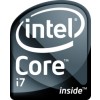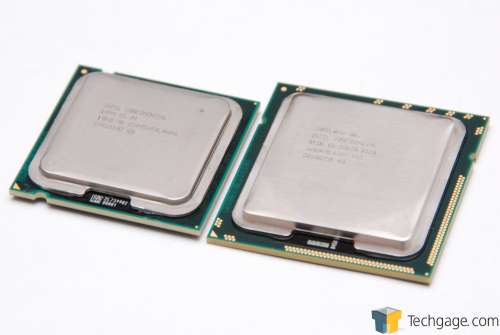- Qualcomm Launches Snapdragon 4 Gen 2 Mobile Platform
- AMD Launches Ryzen PRO 7000 Series Mobile & Desktop Platform
- Intel Launches Sleek Single-Slot Arc Pro A60 Workstation Graphics Card
- NVIDIA Announces Latest Ada Lovelace Additions: GeForce RTX 4060 Ti & RTX 4060
- Maxon Redshift With AMD Radeon GPU Rendering Support Now Available
Intel Core i7 Performance Preview

With Core i7’s launch due in just a few weeks, there’s no better time than right now to take a hard look at its performance, which is what we’re taking care of today. In addition to our usual performance comparisons with last-gen CPUs, we’re also taking an in-depth look at both QPI and HyperThreading performance, and some of our results may surprise you.
Page 1 – Introduction
Two summers ago, Intel helped change all we thought we knew about processors with the launch of their Core 2 micro-architecture. At a time when we thought processor development was beginning to slow down, Core 2 forced our minds to be changed, as the improvements over previous NetBurst products were rather significant.
Since that time, the CPU landscape has changed dramatically. At the time Core 2 first launched, Dual-Cores were still considered to be more of a novelty, and some still were unsure why they were even necessary. For those lucky enough to own one, however, the benefits became clear, and the multi-core revolution was quickly born.
At the same time, the thought of Quad-Core processors did little more than spawn laughter. After all, if most people couldn’t take advantage of a Dual-Core, where did a Quad-Core fit in? Well, thinking about it didn’t last too long, as Intel quickly followed up their initial Core 2 launch with a Quad-Core model in the fall of the same year.
As the amount of developers writing multi-threaded applications grows, the benefits of a Quad-Core CPU is better seen now than ever before. In fact, we posted a list just earlier this week
that proves it. Whether you are a multi-tasker, media buff or someone who simply loves having a lot of headroom, Quad-Cores make an excellent addition to any new PC build.
Welcome to Core i7
Core i7 is almost here, but that will come as a surprise to no one, as potential release dates have been hovering around rumor-ville for months. The official response came last month, during IDF Taipei. There, Intel told the world that we would see Core i7 before the end of November, although no definitive street date was given.
Today’s article will serve as a preview into what to expect from Core i7 from a performance perspective. This will become the first of a few different articles that we’ll be posting in the weeks to come, which will target more specific areas of Nehalem and its platform. So, consider today’s look as a good way to whet your appetite. There’ll be more good stuff en route.
Core i7, or Nehalem as we’ve been calling it for the past year, becomes part of Intel’s “Tock” step, which denotes a brand-new micro-architecture built on the current process node. “Tick” will come next year in the form of Westmere, a 32-nm shrink of Nehalem. If you are not up to speed on everything that the new micro-architecture brings to the table, the next page in this article was made for you.
When Core i7 hits the street, three models will become immediately available. This is a little different than most other Intel launches, which normally see the highest-end part released first. Instead, this launch will also see the release of both the mainstream and mid-range parts. This is a great thing for obvious reasons, so now the only thing to worry about is stock.
|
Processor Name
|
Cores
|
Clock
|
Cache
|
QPI/FSB
|
TDP
|
1Ku Price
|
| Intel Core i7 Extreme 965 |
4
|
3.20GHz
|
8MB
|
3200MHz
|
150W
|
$999
|
| Intel Core i7 940 |
4
|
2.93GHz
|
8MB
|
2400MHz
|
130W
|
$562
|
| Intel Core i7 920 |
4
|
2.66GHz
|
8MB
|
2400MHz
|
130W
|
$284
|
| Intel Core 2 Extreme QX9775 |
4
|
3.20GHz
|
2 x 6MB
|
1600MHz
|
150W
|
$1,499
|
| Intel Core 2 Extreme QX9770 |
4
|
3.20GHz
|
2 x 6MB
|
1600MHz
|
136W
|
$1,399
|
| Intel Core 2 Extreme Q9650 |
4
|
3.00GHz
|
2 x 6MB
|
1333MHz
|
130W
|
$530
|
| Intel Core 2 Quad Q9550 |
4
|
2.83GHz
|
2 x 6MB
|
1333MHz
|
95W
|
$316
|
| Intel Core 2 Quad Q9450 |
4
|
2.66GHz
|
2 x 6MB
|
1333MHz
|
95W
|
$316
|
| Intel Core 2 Quad Q9400 |
4
|
2.66GHz
|
2 x 3MB
|
1333MHz
|
95W
|
$266
|
| Intel Core 2 Quad Q9300 |
4
|
2.50GHz
|
2 x 3MB
|
1333MHz
|
95W
|
$266
|
| Intel Core 2 Quad Q8200 |
4
|
2.33GHz
|
2 x 2MB
|
1333MHz
|
95W
|
$193
|
The top-of-the-line i7 processor will be the Extreme 965, at 3.20GHz. As is typical of all newly-launched Intel Extreme editions, this one will be sold at a price of $999 in quantities of 1,000. This means that you can expect a price of closer to $1,100 if you wish to own one. Moving downwards, the 2.93GHz model will sell for $562, while the mainstream 920 will be sold at $284.
Like previous Extreme products, the 965 will be a fully-unlocked chip with a Turbo multiplier capable of hitting 40x, the default being 24x. The 940 and 920 are capped at their stock multipliers (22x and 20x, respectively) and can only be overclocked by increasing the Base Clock, or BCLK for short. That tells us right away that these processors are going to be more of a challenge to overclock than anything from the Core 2 line-up, and we’ll get into the specifics of why later.
We won’t be covering overclocking to a great extent in this initial article, but stay tuned as we’re preparing a dedicated article about it which will be posted at some point this week. Without getting too far off-track, let’s take a look at Intel’s latest baby, shall we?
Comprised of 731 million transistors on a surface area of 263mm^2, Intel’s latest processor is a little bit of a strange beast, since it’s larger in areal density than its predecessor (214mm^2), but uses less transistors. Why that’s the case exactly, I’m unsure.
In the above image, you can see a direct comparison of the QX9770 (left) sitting next to the Core i7 965 (right), but contrary to what you may believe, the reason for the larger overall CPU isn’t entirely attributed to the physically larger die. Rather, because of all of Nehalem’s enhancements, additional pins were required, and by additional, I mean many additional, as you can see in the below photo:
Each of the i7 processors to be launched later this month have identical pin and filter cap layouts on the back, which leads us to believe that each is identical inside, with the obvious multiplier and model code changes. In previous architectures, some of the filter caps would be laid out differently, or some would be missing on the smaller models, but not here. We could assume that smaller models, when eventually released, will look slightly different on the back.
As mentioned above, today’s article is a preview, not a review, as there is a lot more testing that needs to be conducted that couldn’t yet be focused on due to time. So, we’ll be following-up with more specific content over the course of the next few weeks, including a deeper look at gaming performance and overclocking. We’ll finish it all off with a proper “review” nearer to the official launch.
Today’s article will be focusing primarily on two things. First will be simple performance scaling between the three new processors and three top processors from Intel’s Kentsfield line-up, including the QX9770 and Q9450. The second will be a performance look at Core i7’s new features, including Turbo and HyperThreading. I can assure you… these are results you won’t want to skip over.
For a recap of the most important features of Nehalem, turn to the next page. Afterwards, we’ll cover all considerations you should bear in mind if you plan to build a new machine with a Core i7 processor at the… uhh, core.
Support our efforts! With ad revenue at an all-time low for written websites, we're relying more than ever on reader support to help us continue putting so much effort into this type of content. You can support us by becoming a Patron, or by using our Amazon shopping affiliate links listed through our articles. Thanks for your support!








